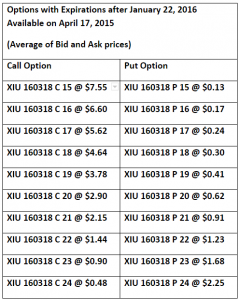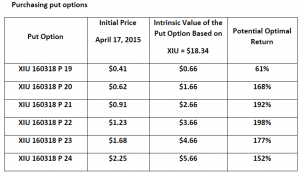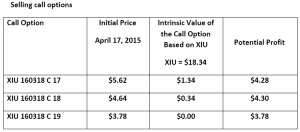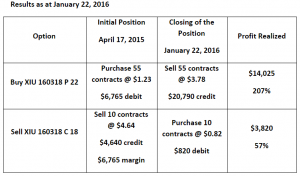Purchasing Put Options or Selling Call Options to Protect Oneself? (Third and Last Part)

In the two previous articles, we compared purchasing put options as a protective strategy with selling covered call options. The first article used options with monthly expirations, and the second article used options expiring after our period of analysis, from April 17, 2015 to January 22, 2016. In both cases, the analysis led us to conclude that it is preferable to use call options as protection against an expected decline over a given period of time. But does this really mean that we should never purchase put options? The present article analyzes how to make effective use of put options, but this time, rather than using the options for protection, our goal is to take advantage of an expected drop in the stock price.
Background
Consider that it is now April 17, 2015, and we believe that XIU, which is trading at $22.55, will begin trending downward. Furthermore, we believe that it will fall 18.7% to reach $18.34 on January 22, 2016. Suppose that we have a cash balance of $6,765 in our trading account. Given this situation, we want to compare purchasing put options and selling call options again, but this time we will use uncovered call options. The goal is to see which strategy provides the best return following the expected decline in the underlying asset. Among all the available options, we will select the put option with the best return based on a target price of $18.34, and we will compare this with selling uncovered call options. We will choose our options from the options with expirations immediately after January 22, 2016, i.e. with the March 18, 2016 expiration.



We select the put option with the best return, based on the intrinsic value arising from our target price for XIU of $18.34. In this instance, we choose the put option XIU 160318 P 22, at $1.23, with a potential return of 198%. With $6,765 of available funds, we can purchase exactly 55 contracts.

Choosing which call option to sell should not be based on the optimal return but rather on the highest dollar profit, since selling uncovered put options requires that we provide a margin rather than pay a premium. We therefore select the call option that gives the highest profit, based on a target price for XIU of $18.34. We have compared call options with strikes of $17, $18 and $19 that we could sell for $5.62, $4.64 and $3.78, respectively. We then calculated the intrinsic value of each option: $1.34, $0.34 and $0.00, respectively, based on a price of $18.34 for XIU. We then determined that the potential profit of each of these options would be $4.28, $4.30 and $3.78, respectively. Based on this information, we decided to sell call options XIU 160318 C 18 at $4.64. With $6,765 cash on hand, we can sell only 10 call option contracts. The number of contracts is calculated by applying a 30% margin to the value of XIU, as if we were selling the security directly instead of selling options on it (a simplified approach for the purposes of this article). However, these two methods should not produce significantly different results.
So, 30% x $22.55 = $6.765 of margin required for each share. Since we have $6,765 cash on hand, we can sell 10 put options XIU 160318 C 18, at a price of $4.64.

On January 22, 2016, we closed our positions at the market price while there was still some time before our options expired on March 18, 2016. As we can see, now the strategy of purchasing put options is by far more profitable, yielding a profit of $14,025 and a return of 207% on the available capital, compared to the strategy of selling call options, which gave a profit of $3,820 and a return of 57% on the available capital.
Given the results of these three comparative articles, we can conclude that there is no single approach that can be applied in all situations. Just as we need more than just a hammer in our toolbox when renovating, as investors we need to draw from a range of available strategies based on our specific objectives. The three articles used scenarios whose results leave no room for doubt, since in each case we knew the outcome. However, in real life, there are uncertainties, so we need to consider the possibility that the market will not confirm our expectations. When implementing a strategy, we need to wonder: “What will happen if the market continues going up, rather than falling as we expect?” We need to assess the potential losses, too, not only our potential profits, in order to reach our goals.
To recap, in the first article, we used monthly options to follow the market as it fell.
Selling call options was the better strategy
In the second article, we used options with expirations after January 22, 2016.
Once again, selling call options was the better strategy
Lastly, in this article we made maximum use of our capital, and purchasing put options was the better strategy.
Each new situation requires properly identifying the inherent risks associated with each of the option strategies at our disposal. This means that if you are 100% sure of your scenario, some strategies will perform better than others, as we have shown. However, if you are confident but have some doubts, it may be better to use a different strategy with some potential for profit but that is not restrictive. So, as we saw in the first two articles, purchasing put options allowed us to benefit if the market rose rather than fell as we expected, even if the return was smaller. What has been important in this article is the potential loss if the stock price rises. When purchasing put options, the downside risk is the total loss of our available capital of $6,765 if XIU closes above the strike price of $22 when our options expire on March 18, 2016. In contrast, when selling call options, a loss of $6,765 ($6.76 per share) will only occur if XIU closes at a price above $29.31 ($22.55 + $6.76). This strategy therefore gives us greater flexibility.
Only once we have a good understanding of each strategy, can we make informed, well-justified decisions.
Good luck with your trading, and have a good week!
The strategies presented in this blog are for information and training purposes only, and should not be interpreted as recommendations to buy or sell any security. As always, you should ensure that you are comfortable with the proposed scenarios and ready to assume all the risks before implementing an option strategy.
President
Monetis Financial Corporation
Martin Noël earned an MBA in Financial Services from UQÀM in 2003. That same year, he was awarded the Fellow of the Institute of Canadian Bankers and a Silver Medal for his remarkable efforts in the Professional Banking Program. Martin began his career in the derivatives field in 1983 as an options market maker for options, on the floor at the Montréal Exchange and for various brokerage firms. He later worked as an options specialist and then went on to become an independent trader. In 1996, Mr. Noël joined the Montréal Exchange as the options market manager, a role that saw him contributing to the development of the Canadian options market. In 2001, he helped found the Montréal Exchange’s Derivatives Institute, where he acted as an educational advisor. Since 2005, Martin has been an instructor at UQÀM, teaching a graduate course on derivatives. Since May 2009, he has dedicated himself full-time to his position as the president of CORPORATION FINANCIÈRE MONÉTIS, a professional trading and financial communications firm. Martin regularly assists with issues related to options at the Montréal Exchange.
The information provided on this website, including financial and economic data, quotes and any analysis or interpretation thereof, is provided solely for information purposes and shall not be construed in any jurisdiction as providing any advice or recommendation with respect to the purchase or sale of any derivative instrument, underlying security or any other financial instrument or as providing legal, accounting, tax, financial or investment advice. Bourse de Montréal Inc. recommends that you consult your own advisors in accordance with your needs before making decision to take into account your particular investment objectives, financial situation and individual needs.
All references on this website to specifications, rules and obligations concerning a product are subject to the rules, policies and procedures of Bourse de Montréal Inc. and its clearinghouse, the Canadian Derivatives Clearing Corporation, which prevail over the content of this website. Although care has been taken in the preparation of the documents published on this website, Bourse de Montréal Inc. and/or its affiliates do not guarantee the accuracy or completeness of the information published on this website and reserve the right to amend or review, at any time and without prior notice, the content of these documents. Neither Bourse de Montréal Inc. nor any of its affiliates, directors, officers, employees or agents shall be liable for any damages, losses or costs incurred as a result of any errors or omissions on this website or of the use of or reliance upon any information appearing on this website.
BAX®, CADC®, CGB®, CGF®, CGZ®, LGB®, MX®, OBX®, OGB®, OIS-MX®, ONX®, SCF®, SXA®, SXB®, SXF®, SXH®, SXM®, SXO®, SXY®, and USX® are registered trademarks of the Bourse. OBW™, OBY™, OBZ™, SXK™, SXJ™, SXU™, SXV™, Montréal Exchange and the Montréal Exchange logo are trademarks of the Bourse. All other trademarks used are the property of their respective owners.
© 2024 Bourse de Montréal Inc. All Rights Reserved.
